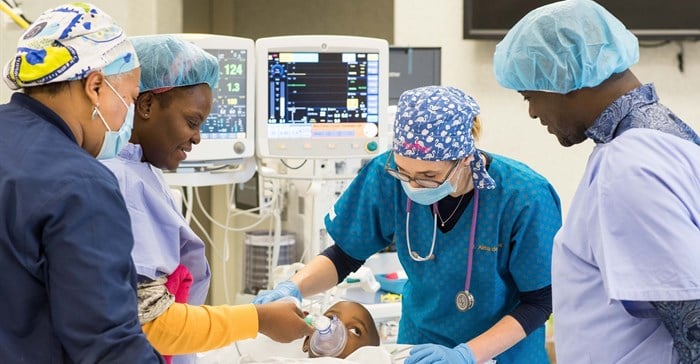
Van Ness rotationplasty is a surgical procedure used to treat bone cancer of the lower limb where standard limb-saving reconstructions are not possible.
It consists of shortening of the leg with a rotation of 180 degrees of the lower leg which is adapted to the remaining upper leg bone (femur), changing the ankle function into a new knee joint.
“The procedure provides patients with more function than a traditional amputation would, as the patient’s ankle acts as a substitute for the knee joint.
"It allows a prosthesis to fit more comfortably, providing better leg mobility and stability than patients who undergo a full high-above-knee amputation,” says Dr Thomas Hilton, orthopaedic oncology and joint-replacement surgeon at Life Orthopeadic Hospital at Life Vincent Pallotti Hospital in Cape Town.
Dr Hilton met the five-year-old Angolan patient, who had bone cancer in the lower part of the femur, when he travelled to Namibia for an orthopaedic oncology outreach programme in the Windhoek Central state hospital. “Standard limb-salvage procedures were not possible for the child due to the extent of the tumour and a Van Ness rotationplasty was deemed to be the best surgery for her,” added Hilton.
Dr Hilton led the unique six-hour pro-bono procedure at Life Orthopeadic Hospital with support from Life Vincent Pallotti Hospital specialists and Dr Alma De Waal an anaesthetist from Groote Schuur Hospital.
“This is a great example of how public-private partnership can help patients,” he said.

Hilton explained that standard methods use mega-prosthetics or healthy bone-tissue transfers with titanium plating systems. In a Van Ness rotationplasty the middle and lower section of the femur, including the knee, is removed along with the cancer and the lower shin (tibia), ankle, and foot are then rotated 180 degrees and reattached to the remaining thigh or femur bone.
According to Hilton, a rotationplasty is more common in young children because they have so much growth remaining in their skeleton that standard prosthetics would leave them with a limb that would be too short to be useful.
Most children recover well from rotationplasty and are more likely to adapt to the prosthesis because they are young and learn much faster than adults.
They can usually resume activities, such as running, ballet, climbing trees or playing soccer.
“I am truly privileged to be able to work with bone and soft-tissue tumour/sarcoma patients. They are some of the bravest patients in the world.
“Bone tumours or bone sarcomas like osteosarcoma do not get enough airtime in the media and exposure to fundraising and research. Fortunately, they are rare cancers.
"This doesn’t make it any less difficult for the patients who are diagnosed with them. They are usually young with their whole lives ahead of them and face gruelling chemotherapy and life-altering reconstructive surgery. In modern medicine we can perform limb-salvage surgery in more than 90% of cases,” explains Hilton.

He continued to add that in a small number of patients, limb saving is not possible, and amputation is necessary to provide local control of the tumour.
Some amputations are morbid and do not leave the patient with a good function ability due to short amputation stumps. There are also cultural and traditional fears and concerns that impact decision-making and acceptance of traditional amputation.
“Van Ness rotationplasty provides a good functional option for young patients where traditional methods of saving a limb are not possible.
"It is not an easily accepted reconstructive method due to its unusual cosmetic appearance. We hope that this brave patient and family will serve as ambassadors to help counsel future patients considering a Van Ness rotationplasty,” concluded Hilton.
“We are proud of the clinical accomplishments and milestones of our Life Orthopaedic Hospital team, of course with the support of our complementary services and medical-aid funders,” said Gavin Pike, hospital manager at Life Vincent Pallotti Hospital.